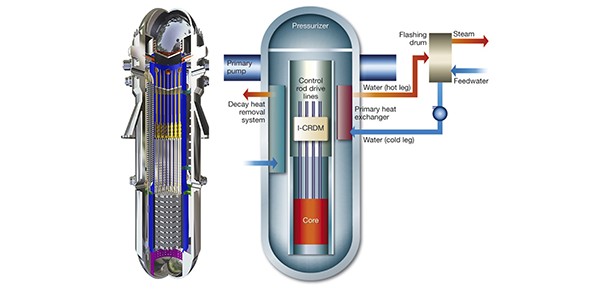
The University of Cambridge is playing a key role in an international project to develop a radical new type of nuclear power station that is safer, more cost-effective, more compact and much quicker and less disruptive to build than any previously constructed.
If all goes to plan, construction of the first I2S-LWRs could begin in around 10 years, making deployment of nuclear power more practical, more cost-effective and more publicly acceptable worldwide.
Dr Geoff Parks
With Engineering and Physical Sciences Research Council (EPSRC) funding, a team at Cambridge University is exploring whether the element thorium could help to meet the new design’s fuel needs. As well as being three to four times more abundant than uranium, thorium could potentially produce electricity more fuel efficiently and therefore more cheaply.
The aim of the overall project, initiated by the US Department of Energy and led by Georgia Institute of Technology, is to design a power plant whose size would be reduced and safety enhanced by breaking with convention and integrating the main heat exchangers inside the secure pressure vessel where the nuclear reactions take place. This innovation gives the design its name: Integral Inherently Safe Light Water Reactor (I2S-LWR).
The I2S-LWR, which could also be built module by module off-site and then quickly assembled on site, would be suitable for deployment worldwide. In this country, it could contribute to a new era of nuclear power that helps the UK meet its carbon reduction targets and energy security objectives; no new nuclear power station has been built here since Sizewell B began generating in 1995. With a power rating of around 1GW, the output from the I2S-LWR would be comparable with Sizewell B’s 1.2GW rating, but the station should be significantly less costly in real terms.
The EPSRC-funded part of the project will help the UK reinvigorate its technical expertise in civil nuclear power and attract a new generation of engineers and scientists to the field. Expertise of this kind will be crucial to securing the UK’s nuclear future but has significantly diminished during the 20 year ‘nuclear hibernation’ where no new nuclear power stations have come on stream in this country.
The Cambridge team will focus on how thorium, which can be converted into the isotope uranium-233, could be used alongside uranium silicide to fuel the I2S-LWR. The team will assess the question not just from the perspective of fundamental nuclear reactor physics but also in terms of the scope to achieve high fuel-to-power conversion efficiency and to recycle spent nuclear fuel – key issues impacting the cost-effectiveness of the thorium fuel option.
The Department's Dr Geoff Parks, who is leading the Cambridge team, says: “The fact that we are part of such a pioneering international project not only reflects the UK’s enduring reputation in nuclear science and engineering – it also provides a platform for the UK to develop a new suite of relevant, globally marketable skills for the years and decades ahead. If all goes to plan, construction of the first I2S-LWRs could begin in around 10 years, making deployment of nuclear power more practical, more cost-effective and more publicly acceptable worldwide.”

